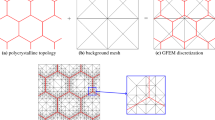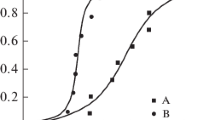Abstract
We propose a physical model of quasibrittle fracture of polycrystalline metals as applied to the most general case of the complex stressed state and nonuniform distributions of stress and strain fields. Within the framework of this model, on the basis of the analysis of elementary acts of the process of initiation and loss of stability of incipient cracks, we explain, for the first time, the basic regularities of the variation of the local stress of quasibrittle fracture σc, of a metal under the conditions of stress concentration. It is shown that the value of σc depends not only on the length of incipient cracks but also on their number in the local plastic zone at the notch tip and on the law of their distribution over orientations. On this basis, we explain the causes of the, influence of the acuity of the notch and testing temperature on σc. It is shown that the application of the proposed model in combination with the finite-element method makes it possible to predict (with sufficiently high accuracy) both the mean value and the spread of the fracture load of a specimen with stress concentrator of any acuity, including fatigue cracks.
Similar content being viewed by others
Abbreviations
- ε:
-
intensity of microplastic strains
- e c :
-
level of critical macrodeformation
- e p i :
-
intensity of macroplastic deformation
- F 1(ξ c ):
-
probability of the loss of stability of a submicrocrack under tensile microstresses ξ c
- F 1(ξ):
-
probability density of this quantity
- F 3(σ c ):
-
probability of the loss of stability of a submicrocrack under tensile macrostresses σ c
- F 3f (σ i ,e p i ):
-
probability of the loss of stability of an incipient crack in an elementary volume under local macroscopic stressesσ 1 for the intensity of local macroplastic strainse p i
- \(F_{n_j } (\sigma _1 e_i^p )\) :
-
probability of fracture of an elementary volume
- F n ,F min n ,F max n :
-
probability of fracture of the specimen, its minimum and maximum values, respectively
- f 2(ε; lnd g ):
-
density of the joint distribution of the intensity of microplastic strains and the lograithms of grain sizes
- I(ɛ),I(ξ 11):
-
coefficients of variation of the intensity of microplastic strains ε and microstressesξ 11, respectively
- K :
-
coefficient that characterizes the resistance of the crystal lattice of the metal to the propagation of a submicrocrack
- K 1c :
-
fracture toughness
- N a :
-
number of initiated incipient cracks
- R mc :
-
minimum fracture stress within the temperature range of the ductile-brittle transition under uniaxial tension
- t :
-
constant (t≈3)
- T z.p :
-
temperature of zero plasticity
- V :
-
volume of a polycrystal
- \(\bar V_g \) :
-
mean volume of a grain
- V j :
-
elementary volume
- V c :
-
volume of the “process zone”
- X * c :
-
diameter of the process zone in the minimum section of the specimen
- X p :
-
distance from the notch tip to the point where the probability of fracture is maximum
- X σ :
-
distance from the notch tip to the point of action of the maximum tensile macrostressesσ max1
- φ(θ,η):
-
function taking into account the effect of the orientation of a submicrocrack (θ) and the type of a microstressed state (η) onξ c
- σ Nc :
-
nominal fracture stress
- σ Y :
-
yield limit of the metal
- ξ c :
-
critical level of microstresses at which incipient cracks become unstable
- \(\bar \xi \) :
-
mean weighted level of microstresses induced by dislocations in the plane of the incipient crack
- ξ 11,ξ max11 :
-
current level of tensile microstresses and their maximum level, respectively
- ψ:
-
relative narrowing of a notched section of a specimen with stress concentrator
References
G. V. Uzhik,Tensile Resistance and Strength of Metals [in Russian], Izd. Akad. Nauk SSSR, Moscow (1950).
L. A. Kopel'man,Resistance of Welded Units to Brittle Failure [in Russian], Mashinostroenie, Leningrad (1978).
J. Knott,Fundamentals of Fracture Mechanics, Butterworths, London (1973).
S. A. Kotrechko, Yu. Ya. Meshkov, D. I. Nikonenko, and G. S. Mettus, “Mechanics and physics of quasibrittle fracture of polycrystalline metals under conditions of stress concentration. Part 1. Experimental regularities,”Probl. Prochn., No. 4, 5–16 (1997).
W. A. Weibull, “A statistical theory of strength of materials,”Proc. Roy. Swed. Inst. Eng. Res., No. 15, 5–45 (1939).
F. M. Beremin, “A local criterion for cleavage fracture of a nuclear pressure vessel steel,”Met. Trans.,14A, No. 11, 2277–2287 (1983).
Y. Matsuo, “Statistical fracture theory for multiaxial stress states using a Weibull three-parameter function,”Eng. Fract. Mech., No. 4, 527–532 (1981).
P. M. Vitvitskii and S. Yu. Popina,Strength and Criteria of Brittle Fracture of Stochastically Defective Bodies [in Russian], Naukova Dumka, Kiev (1980).
T. Lin, A. G. Evans, and R. O. Ritchie, “Statistical analysis of cleavage fracture ahead of sharp cracks and rounded notches,”Acta Met.,34, No. 11, 2205–2216 (1986).
B. Strnadel, “Critical characteristic ligament for cleavage fracture in spheroidized steels,”Theor. Appl. Fract. Mech., No. 19, 105–111 (1993).
Yu. Ya. Meshkov and G. A. Pakharenko,Structure of Metals and Brittleness of Steel Products [in Russian], Naukova Dumka, Kiev (1985).
S. A. Kotrechko, “Statistical model of brittle fracture of polycrystalline metals,”Met. Phys. Adv. Tech.,14, No. 10, 1099 (1995).
J. J. Levandowski and A. W. Thompson, “Micromechanism of cleavage fracture in fully pearlitic structures,”Acta Met.,35, No. 7, 1453–1462 (1987).
P. Bowen, S. G. Druce, and J. F. Knott, “Micromechanical modeling of fracture toughness,”Acta Met.,35, No. 7, 1735–1746 (1987).
V. P. Karzov, B. Z. Margolin, and V. A. Shvetsova, “Some physicomechanical approaches to the analysis of macroscopic fracture criteria. Part 3. Brittle fracture,”Probl. Prochn., No. 7, 12–21 (1989).
K. S. Kuhne und W. A. Einflub, “Einfluß des Spannugsunstandes und des Gefuges auf die Spaltbruchspannung von Baustählen,”Arch. Eisenhüttenwes, No. 11, 39–40 (1983).
Yu. Ya. Meshkov, G. A. Pakharenko, and A. V. Shevchenko, “Effect of the morphology of cementite on the brittle fracture of steel,”Metallofizika,6, No. 4, 68–71 (1984).
Additional information
Institute of Physics of Metals, National Academy of Sciences of Ukraine, Kiev, Ukraine. Translated from Problemy Prochnosti, No. 3, pp. 5–16, May–June, 1999.
Rights and permissions
About this article
Cite this article
Kotrechko, S.A., Meshkov, Y.Y. Mechanics and physics of quasibrittle fracture of polycrystalline metals under conditions of stress concentration. Part 2. Theoretical basis. Strength Mater 31, 223–231 (1999). https://doi.org/10.1007/BF02511000
Received:
Issue Date:
DOI: https://doi.org/10.1007/BF02511000




